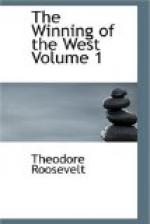48. On July 25th.
49. I have given the account of Floyd’s journey at some length as illustrating the experience of a typical party of surveyors. The journal has never hitherto been alluded to, and my getting hold of it was almost accidental.
There were three different kinds of explorers. Boon represents the hunters; the McAfees represent the would-be settlers; and Floyd’s party the surveyors who mapped out the land for owners of land grants. In 1774, there were parties of each kind in Kentucky. Floyd’s experience shows that these parties were continually meeting others and splitting up; he started out with eight men, at one time was in a body with thirty-seven, and returned home with four.
The journal is written in a singularly clear and legible hand, evidently by a man of good education.
50. The latter, from his name presumably of Sclavonic ancestry, came originally from New York, always a centre of mixed nationalities. He founded a most respectable family, some of whom have changed their name to Sandusky; but there seems to be no justification for their claim that they gave Sandusky its name, for this is almost certainly a corruption of its old Algonquin title. “American Pioneer” (Cincinnati, 1843), II., p. 325.
CHAPTER VII.
SEVIER, ROBERTSON, AND THE WATAUGA COMMONWEALTH, 1769-1774.
Soon after the successful ending of the last colonial struggle with France, and the conquest of Canada, the British king issued a proclamation forbidding the English colonists from trespassing on Indian grounds, or moving west of the mountains. But in 1768, at the treaty of Fort Stanwix, the Six Nations agreed to surrender to the English all the lands lying between the Ohio and the Tennessee;[1] and this treaty was at once seized upon by the backwoodsmen as offering an excuse for settling beyond the mountains. However, the Iroquois had ceded lands to which they had no more right than a score or more other Indian tribes; and these latter, not having been consulted, felt at perfect liberty to make war on the intruders. In point of fact, no one tribe or set of tribes could cede Kentucky or Tennessee, because no one tribe or set of tribes owned either. The great hunting-grounds between the Ohio and the Tennessee formed a debatable land, claimed by every tribe that could hold its own against its rivals.[2]
The eastern part of what is now Tennessee consists of a great hill-strewn, forest-clad valley, running from northeast to southwest, bounded on one side by the Cumberland, and on the other by the Great Smoky and Unaka Mountains; the latter separating it from North Carolina. In this valley arise and end the Clinch, the Holston, the Watauga, the Nolichucky, the French Broad, and the other streams, whose combined volume makes the Tennessee River. The upper end of the valley lies in southwestern Virginia, the head-waters




